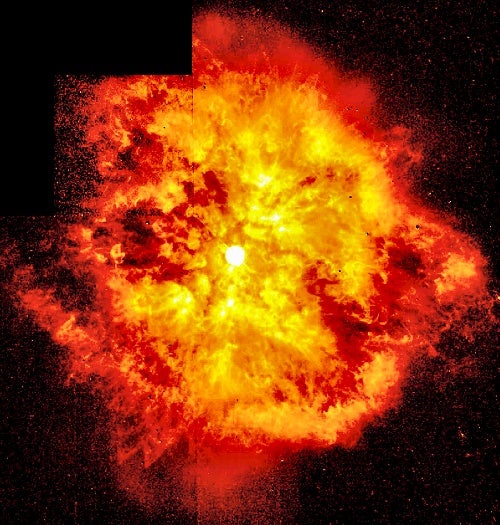While it may be small and cheap as space telescopes go, a suitcase-size, $10-million Canadian microsatelllite is making discoveries out of the reach of even the powerful Hubble. Dubbed affectionately the ‘Humble’ space telescope, MOST (Microvariability and Oscillation of Stars) is the world’s tiniest space-based observatory. It measures minute pulsations of stars.
Nearing the end of its second year of operation, this stellar sentinel already has provided clues to the inner clockwork of a menagerie of stars from dying dwarfs to massive exotics. Fresh data also indicate MOST has detected the reflected starlight from a giant exoplanet, even offering hints of its weather.
Out of tune
Recently, MOST studied a nearby Sun-like star and detected internal vibrations that appear to be out of tune with predicted models, leaving astrophysicists scratching their heads. The telescope detected tiny optical changes in the star Eta (η) Boötis caused by a chorus of harmonic sound waves bouncing around inside the star. All theoretical star models to date propose a different chorus of oscillations.
These vibrations reveal the inner workings of Eta Boötis and pin down its age to 2.4 billion years, with an accuracy around 1 percent. This betters all previous estimates for any star’s age by about tenfold, according to the MOST team. “Our technique is extremely powerful in giving ages to individual stars,” adds Jaymie Matthews of the University of British Columbia and principal investigator for MOST.
MOST can detect stars’ brightness fluctuations as small as one part in a million — 10 times better than ground-based telescopes can achieve. Using astro-seismology — the study of starquakes — astronomers study brightness variations and construct complete light curves, thanks to the around-the-clock monitoring afforded by a space-based instrument.
By placing the 37-light-year-distant Eta Boötis under a stellar stakeout, astronomers hope newly revised models will give them a better understanding of our Sun’s evolutionary pathway.
“Much of what we know about stars — what powers them, how they evolve over time, how they produce the elements that make up life, and what their role is in the evolution of our galaxy and the universe — comes from computer models,” explains David Guenther, MOST team scientist from St. Mary’s University in Halifax, Nova Scotia. “Our understanding of the Sun and other stars is only as good as our ability to match data to models. Better data from new instruments like MOST forces us to produce better models.”
Cracking open a giant
MOST scientists also have revealed the hidden life of a seemingly violent, chaotic star on the verge of becoming a supernova 19,000 light-years away. The star, WR123, belongs to a select group of exotics — Wolf-Rayet stars — known for its fast and furious lifestyle. All evidence until now suggested WR123 underwent erratic brightness changes associated with turbulent high-speed wind ejected from its atmosphere.
According to calculations, WR123 belches out 100 trillion tons of gas every second and is at least 10 times more massive than our Sun. So, it surprised astronomers when, after 5 weeks of constant monitoring with MOST, they discovered a 10-hour cycle in its light variations. As a result, theories of the inner clockwork of the 200 or so Wolf-Rayet stars scattered throughout our Milky Way will have to be revised.
“Finding a clock in a star like WR123 is like finding the Rosetta stone for astronomers studying massive stars,” explains Laure Lefevre, a Ph.D. student studying Wolf-Rayet stars at the Université de Montréal. The gases spewed from these dying giants are thought to pepper interstellar regions with the building blocks needed for the next generation of stars.
“We may be seeing an example of one of the key stages in the stellar life cycle that led to the Sun, Earth, and us being here,” adds Lefevre.
Hide and seek
Adding to the MOST team’s excitement, the plucky little telescope staked out an alien world around a far-off star and turned up subtle hints of an atmosphere and possible cloud cover. NASA’s Spitzer Space Telescope detected infrared radiation from exoplanet HD209458b earlier this year. MOST tracked the subtle dip in brightness as the planet slipped behind its parent star during its orbit.
“Imagine trying to see a mosquito buzzing around a 400-Watt streetlamp. But not at the street corner, or a few blocks away, but 1,000 kilometers away!” says Matthews. “That’s equivalent to what we’re trying to do with MOST to detect the planet in the HD209458 system.”
The team discovered the extrasolar planet is a gas giant parked less than 1/20 the Sun-Earth distance from its star and is larger than Jupiter but less reflective. Because HD209458b reflects less than 40 percent of the incoming starlight (compared to 50 percent for a Jupiter-size planet), astronomers believe this narrows down the kind of atmosphere that envelops the planet.
MOST will conduct a 45-day stakeout of the system later this summer. “Eventually, the planet will emerge from the noise, and we’ll have a clearer picture of the composition of the exoplanet atmosphere and even its weather — temperature, pressure, and cloud cover,” says Matthews.










